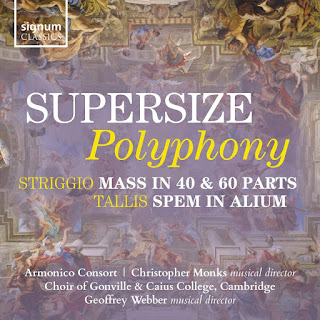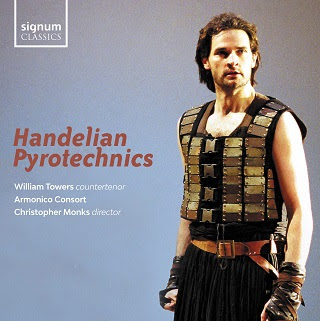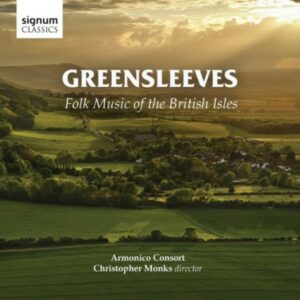Program: #23-06 Air Date: Feb 06, 2023
To listen to this show, you must first LOG IN. If you have already logged in, but you are still seeing this message, please SUBSCRIBE or UPGRADE your subscriber level today.
The multi-voice masses of Alessandro Striggio, folk music from the British Isles, and “Handelian Pyrotechnics” with countertenor William Towers.
I. Greensleeves: Folk Music from the British Isles (Signum CD SIGCD447).
"I don't know what they're putting in the coffee over there at Signum Classics, but this is another brilliant wonder, and obviously a labour of love for all concerned." (Classical Nowhere)
"Best are solo contributions from soprano Eloise Irving and tenor Matthew Vine, who take the lead in the exquisite opener, Lisa Lan." (Gramophone)
"This is a disc which works because the singers combine fine musical quality with a sympathy and enthusiasm for their material, giving us a delightfully evocative 50 minutes." - Planet Hugill, May 2016 "The best is Holst's version of 'I Love My Love', which develops from simplicity gradually into more elaboration that works." (Early Music Review)
"Here's a richly satisfying traversal of British songs delivered with consummate feeling and eloquence by the Armonico Consort...a delightful recital sung with entrancing beauty." (Choir & Organ)
2. The Blue Bird Charles Villiers Stanford
3. The Banks of my own Lovely Lee Traditional, arr. Geoffrey Webber
4. She Moved Through the Fair Traditional, arr. Toby Young
5. Lay a Garland Robert Pearsall
6. Sweet Kitty Traditional, arr. Geoffrey Webber
7. Suo Gân Traditional, arr. Toby Young
8. I Love my Love Traditional, arr. Gustav Holst
9. Dadl Dau Traditional, arr. Geoffrey Webber
10. Now is the Month of Maying Thomas Morley
11. An Rosen Wyn Traditional, arr. Christopher Monks
12. Greensleeves Traditional, arr. Geoffrey Webber
13. Loch Lomond Traditional, arr. R. Vaughan Williams
14. O Love, ‘tis a Calm Starry Night Traditional, arr. Patrick Hadley
15. Wraggle Taggle Gipsies, O! Traditional, arr. Geoffrey Webber
II. Supersize Polyphony (Signum CD SIGCD560).

Christopher Monks | Geoffrey Webber Musical Directors
Adrian France | bass sackbut*
Striggio Mass in 40 & 60 Parts
Tallis Spem in Alium
Supersize Polyphony is a celebration of large-scale choral works from the 16th century. The unique programme features epic motets, such as Thomas Tallis’ Spem in Alium and Alessandro Striggio’s Ecce Beatam Lucem, alongside his rarely performed 60-part Missa Ecco Si Beato Giorno recorded here for the first time for voices alone. Interspersed with the serene beauty of ethereal chants by Hildegard of Bingen, this recording presents works of magnitude and polyphonic drama in stellar performances by two of the UK’s leading choral ensembles.
Striggio was born in Mantua to an aristocratic family, by 1559 he was working as a musician for Cosimo di Medici in Florence, visiting Venice and going on a diplomatic mission to England in 1567. Ecce beatam lucem was written for a royal marriage at the Bavarian court. Striggio would become friends with the composer Vincenzo Galilei (father of the astronomer), and Striggio himself was the father of Alessandro junior who wrote the libretto for Monteverdi's opera L'Orfeo. Striggio's mass based on the motet was discovered in 2005 and received its first modern performance at the BBC Proms in 2007 (it may well have never been performed in Striggio's lifetime).
In writing the mass Striggio seems to have been very influenced by Venetian polychoral music (his madrigals by contrast were very advanced in style) and he intended the motet and the mass to be performed by a mixture of singers and instruments.
Here Christopher Monks and his choirs perform the music with voices along with just a lone bass sackbut (Adrian France). The result is a very contemporary version of Striggio, but a perfectly valid choice. Heard live, the singers performed in the round which must have been a very striking way to hear the Striggio, where he writes for five choirs of eight voices used in poly-choral blocks. But on the disc there is very much a wall of sound. This is massive music for large architecture (on wonders where in 16th century Munich the motet was performed). Striggio's harmony is relatively static, how could it not be with such forces, and the use of only voices emphasises the blocks, but when harmonic change occurs the moment can be magical. But don't get me wrong, the complexity of this music is immense and part of the enjoyment is listening to the detail.
Tallis was less interested in his choirs answering each other, and instead wove his magic in a piece of large scale polyphony which harks back to the complex pieces he wrote as a young man.
This disc gives us a chance for a different take on this music and Christopher Monks marshals his forces well. The small scale pieces are beautifully done, creating just the right sense of constrast. If you can, listen to this disc in surround so that you are truly enveloped in this magical world.
2 Missa sopra Ecco Sì Beato Giorno: Kyrie (Striggio)*
3 Ave Generosa (Bingen)
4 Missa sopra Ecco Sì Beato Giorno: Gloria (Striggio)*
5 O Virtus Sapientiea (Bingen)
6 Missa sopra Ecco Sì Beato Giorno: Credo (Striggio)*
7 O Vos felices radices (Bingen)
8 Missa sopra Ecco Sì Beato Giorno: Sanctus (Striggio)*
9 Missa sopra Ecco Sì Beato Giorno: Benedictus (Striggio)*
10 Spiritus Sanctus Vivicans (Bingen)
11 Missa sopra Ecco Sì Beato Giorno: Agnus Dei (Striggio)*
12 O Nata Lux (Tallis)
13 Spem in Alium Plainchant (Tallis)
14 Spem in Alium (Tallis)
III. Handelian Pyrotechnics (Signum CD SIGCD658).

Armonico Consort
Christopher Monks Director
William Towers Countertenor
Armonico Consort return to Signum with a collection of Handel arias, performed by leading counter-tenor William Towers. A noted soloist in both opera and oratorio, the programme is taken from roles which Towers has sung across his career in various productions across the globe.
Towers writes: “It is the life-affirming, live-giving aspect of Handel that I’m aiming to celebrate. So frequently his operas reveal their most devastatingly beautiful and uplifting music when life is at its darkest. Here the arias shine brightest, here we find Radamisto’s ‘Ombra cara’ and the boundlessly optimistic ‘Dopo l’orrore’, looking out beyond the darkest clouds to the faint glimmer of a dawning hope. This is the uncrushable, indomitable spirit that lies in all of us … We just need to take the time to listen.”
From Opera Today:William Towers’ recent recording of Handel arias, with the Armonico Consort directed by Christopher Monks, is aptly named, although – while there are vocal fireworks – it is Towers’ vocal discipline, beguiling tone and ability to shape and sustain a musical line which are most striking and impressive. The majority of the eleven arias presented are examples of the slow, noble type, in which profound human emotions are expressed in music of sublime beauty and stirring eloquence. Many of those selected are well-known favourites – ‘Ombra ma fù’ (Xerxes), ‘Dove sei’ (Rodelinda), ‘Cara sposa’ (Rinaldo), ‘Ombra cara’ (Radamisto) – but there are some less familiar choices too, such as ‘Se possono tanto due luci vezzose’ sung by the eponymous protagonist of Poro, re dell’Indie,which Towers explains was his first Handel role. He adds that, although the opportunity arose some time ago, he delayed making this recording until ‘I had performed a significant number of [Handel’s] operas, and to choose repertoire for a recording that I knew and loved; that I had fully lived with’.
I’ve seen Towers in Handelian roles on two occasions: in the title role of Radamisto at Snape Maltings in November 2018 and, a year later, in a smaller role as the Christian Magician in Rinaldo. What struck me on hearing this disc is just how attractive his countertenor is, the fullness of body and colour enhanced by his even projection and control. In this sequence of arias, he creates credible characters that win our sympathy and understanding, and captures a range of emotions from loneliness to jealousy, loss, courage, desire. His diction is idiomatic and crisp, and he uses the Italian text to deepen the innate lyricism of the line.
Towers is accompanied by a slimmed-down Armonico Consort comprising, in most of the arias, just four strings and theorbo with Christopher Monks directing sensitively and imaginatively from the harpsichord. The one-to-a-part lines are expressive in ‘Ombra ma fù’: one can hear the individual voices within the pulsing crotchets, while leader Kelly McCusker has freedom to inject her own expressive nuances – there’s a lovely accented ‘sob’ or two. The result is both intimate and sensuous. Toby Carr’s theorbo is prominent, rippling across beats and bars, and propelling what is a rather languorous tempo. Handel’s marking is Larghetto, and there should surely be rather more of a gently sway to entrance the ear, and convey Serse’s own infatuation? Soulful rather than sleepy? Towers’ entrance is clarion, and he doesn’t waver an iota through the first long-held note, using his strength and focus to make what is difficult seem effortless. This aria has been transposed down, but it still encompasses a wide range and Towers is as warm at the bottom as he is sweet at the top. The ornamentation is elegant and expertly rendered: expressive appoggiaturas and a neat trill coax meaning from Serse’s praise, “Soave più”.
Rinaldo’s ‘Cara sposa, amante cara’ is prefaced by soulful ‘weeping’ counterpoint in the upper strings, the evocation of the hero’s sorrow and suffering after Almirena’s abduction by the sorceress enhanced by the sparseness of the texture. When the theorbo enters, Carr is more restrained, allowing the eloquence of Poppy Walshaw’s cello motifs to sing clearly. The B section is brief but brisk, incisive but never heavy. Rinaldo’s defiance burns as the final cadence plunges low, before the extravagant but never inappropriately ornamented da capo. Bertarido’s aria of longing for Rodelina, ‘Dove sei, amato’, is likewise gracefully sculpted, though the absence of the preceding recitative, which would have set the aria in context, is disappointing. Instead, Towers’ opening note comes from nowhere, and is held for fifteen seconds, which does seem rather excessive.
From Radamisto we have ‘Qual nave smarrita’, which benefits from plaintive reedy oboes (Geoff Coates and Jane Downer), in which the protagonist bids farewell to his beloved Zenobia. Towers squeezes every ounce of sadness from the final cadence of the B section, “misero cor”, Radamisto’s ‘wretched heart’ truly wrung through the sweetly descending scale which Towers adds. The fervour of ‘Ombra cara’, in which the hero promises to avenge his wife’s death, is enhanced by Siona Spillett’s characterful bassoon playing, although a bit more weight feels needed in the strings. Towers sings with earnestness and strength, communicating Radamisto’s belief that he will be reunited with Zenobia in the afterlife.
Poro’s ‘So possono tanto’ has a bouncier spring in its step. This opera, which dramatises Alexander the Great’s invasion and conquests in India in 327-6 BC, opened Handel’s second season (1730-31) at the Royal Academic of Music and marked Senesino’s triumphant return to the London stage. In this aria, the Indian king Poro, concerned by his wife Cleophide’s visit to the conquering Alexander, sings of the tortures of jealousy, which should invoke pity, not scorn. Towers’ ornamentation of the da capo reprise is judicious; eloquently decorative while still maintaining the essential simplicity of the line. When that line sinks low, the plushness of his countertenor and his expressive use of vibrato give his voice a quite contralto-like timbre.
Guilio Cesare was another of Senesino’s great roles, and Towers and Monks offer two arias from the opera. It’s good to hear the accompanied recitative that precedes ‘Aure, deh, per pietà’, in which Cesare, saved from drowning by propitious Fate, tells of his escape and then laments his loneliness. The instrumental introduction is characterised by persuasive dialogues between the high and low strings and sequences that never sound workaday, and eases effectively into Tower’s flexible recitative in which he communicates Cesare’s weariness, confusion and despair. The broadening of the final phrase, “Solo in quest’erme arene/ Al monarca del mondo errar conviene?” (Alone on these desert sands/ The ruler of the world must wander?), adds to the weight of the falling appoggiaturas and conveys Cesare’s pained exhaustion, while Towers takes “monarca del mondo” high, creating an octave plunge which is expressive of the pathos of the king’s fall. There’s the slightest of tuning issues as Towers turns the corner into the aria, which mars what is otherwise a lovely messa di voce, but the aria has a charming lilt and he makes much of the alliterative text, conveying the deep earnestness of Cesare’s prayer: “Per dar conforto, oh Dio! al mio dolor./ Dite, dov’è, che fa I’dolo del mio sen,/ L’amato e dolce ben di questo cor?” (To give comfort, O God! to my grief, tell me, where is the idol of my breast, the beloved and sweet goodness of this heart?)
From Act 2 comes ‘Al lampo dell’armi’, Cesare’s display of heroic confidence, and the strings duly race insouciantly through their semi-quavers, leaps and accents imitating nonchalant shrugs of self-belief – though this is one aria in which a bigger string section, in particular a stronger bass line, would give more punch. Towers is similarly untroubled by the aria’s technical demands and surges cleanly and relaxedly through the circling runs with agility and accuracy. Orlando’s ‘Cielo! Se tu il consenti’ isn’t the most obvious choice of aria, but there’s no doubting the disintegration of the insanely jealous protagonist’s personality as Towers sails through the rapid triplets with remarkable control, evenness and stamina. When the line loops downwards he crosses the registers seamlessly, and the extensive ornamentation of the da capo is both imaginative and convincing. Again, though, the accompaniment needs to make a bit more impact.
Scene 1 of the final act of Agrippina opens with Ottone’s exclamation of love for Poppea, ‘Tacerò, purchè fedele’. This is an old-fashioned aria accompanied by only bass and continuo, and Walshaw’s ground-like bass line is lithe and characterful. I’d like a little more rhythmic definition in the vocal line – semiquavers, in imitation of the cello, have a tendency to slip into triplets – but as throughout this disc, Towers’ crafting of the ‘drama’ conveyed by the arching musical structure is sure.
After all the sorrows and suffering, the disc ends on a more buoyant note with another of Senesino’s ‘hits’, ‘Dopo l’orrore’ from Ottone, re di Germania. Here, jealousy inspires admiration, as Ottone likens the soothing of Teofane’s troubles and the restoration of love’s assurance to the sun’s brightening of a stormy sky, made more delightful by the preceding gloom. It’s an uplifting conclusion to an accomplished and attractive disc.
Claire Seymour
TRACK LISTING
1 Ombra mai fu (Xerxes, HWV 40)
2 Se possono tanto due luci vezzose (Poro re dell’Indie, HWV 28)
3 Al lampo dell’armi (Giulio Cesare in Egitto, HWV 17)
4 Dall’ondoso periglio – Aure der per pietà (Giulio Cesare in Egitto, HWV 17)
5 Cara Sposa (Rinaldo, HWV 7)
6 Cielo! Se tu il consentí (Orlando, HWV 31)
7 Dove Sei (Rodelinda, regina de’ Longobardi, HWV 19)
8 Qual nave smarrita (Radamisto, HWV 12)
9 Ombra Cara (Radamisto, HWV 12)
10 Tacerò, purchè Fedele (Agrippina, HWV 6)
11 Dopo l’orrore (Ottone, re di Germania, HWV 15)
Composer Info
Charles Villiers Stanford, Robert Pearsall, Thomas Morley, Thomas Tallis, Alessandro Striggio, Hildegard of Bingen
CD Info
Signum CD SIGCD447, Signum CD SIGCD560, Signum CD SIGCD658
